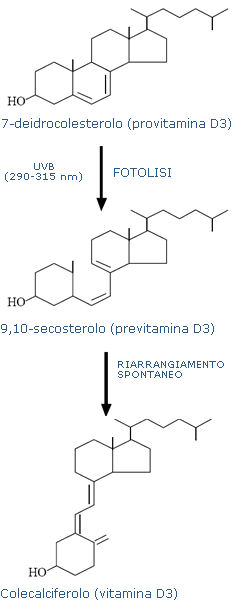Skin synthesis guarantees about 80% of the vitamin D requirement. The remaining percentage (exogenous contribution) derives from the dietary intake of the substance, contained in foods such as the meat of some fatty fish (salmon, mackerel and herring), the yolk egg, liver, fish oils (especially cod liver oil) and in artificially enriched foods.
Man is able to synthesize cholecalciferol starting from a precursor, with the function of provitamin: dehydrocholesterol (derived from cholesterol by reduction). This provitamin is found in the skin, so it absorbs solar radiation energy (especially UVB radiation) which transforms it into an unstable intermediate compound called previtamin D3. This intermediate, known as previtamin D3, spontaneously converts within 48 hours into a thermodynamically more stable compound called Vitamin D3 or cholecalciferol.
 Vitamin D3 synthesized in the skin, similar to that of food origin, must be activated, first in the liver and then in the kidney, in 1,25- (OH) 2-cholecalciferol. This molecule is in fact a biologically active hormone:
Vitamin D3 synthesized in the skin, similar to that of food origin, must be activated, first in the liver and then in the kidney, in 1,25- (OH) 2-cholecalciferol. This molecule is in fact a biologically active hormone:
Promotes the absorption of calcium and phosphorus in the intestine.
Increases bone resorption (stimulates osteoclast differentiation).
Increases the ability of parathyroid hormone to reabsorb calcium in the kidney.
In our latitudes, the amount of sunlight required for the synthesis of vitamin D is relatively small, but in the summer months it is still very important to expose the face and arms to the sun for at least a few minutes a day in order to ensure adequate synthesis. vitamin D skin and set aside reserves for the winter. UVB radiation does not penetrate the glass, so exposure to the sun through a window is not functional to the synthesis of vitamin D.


























